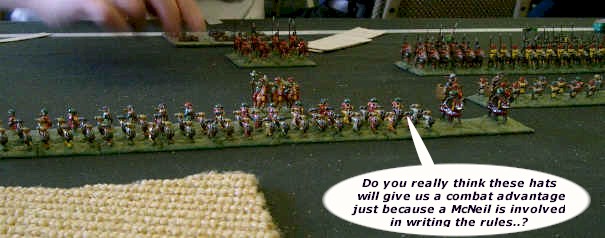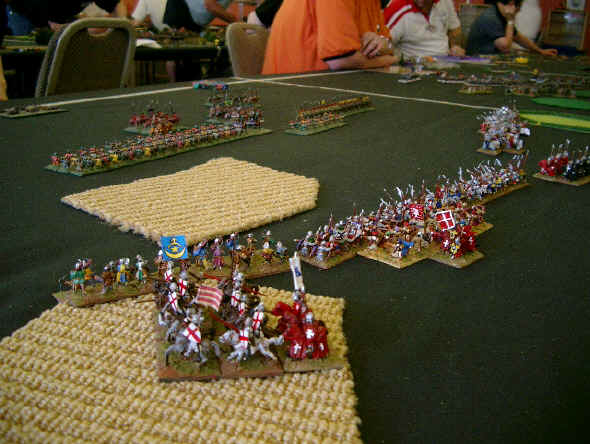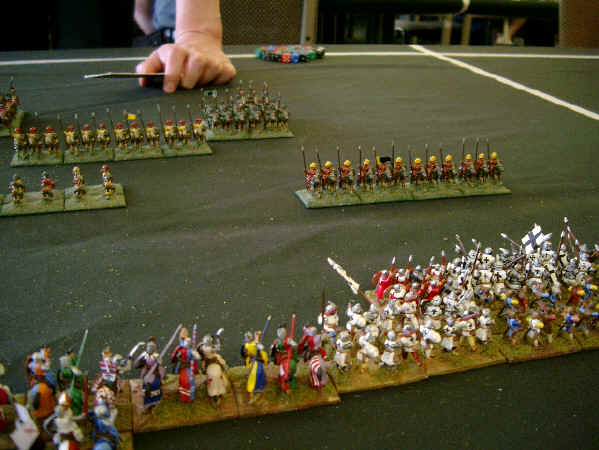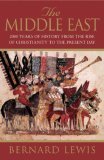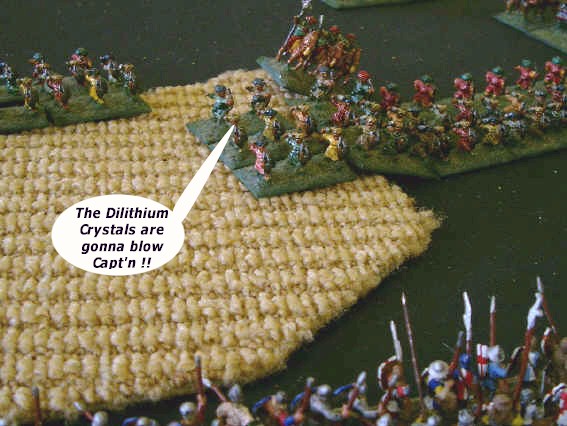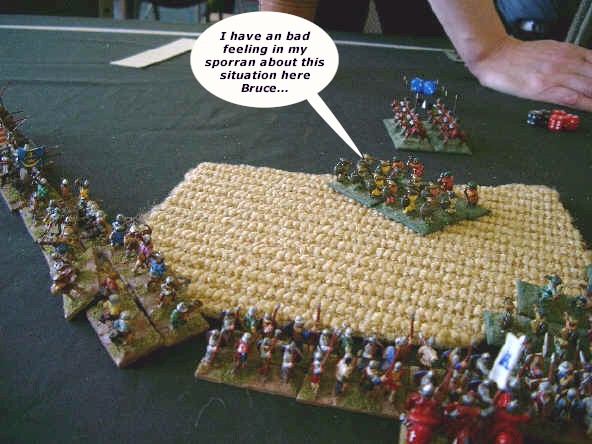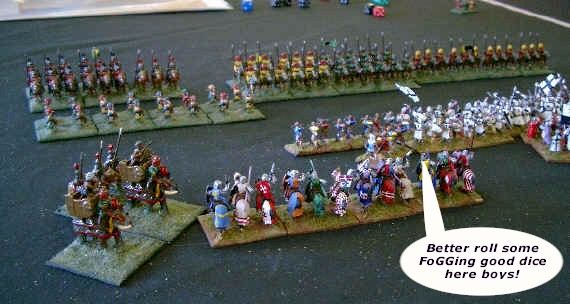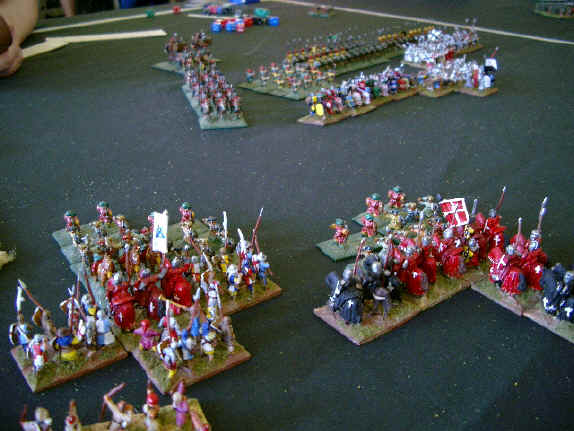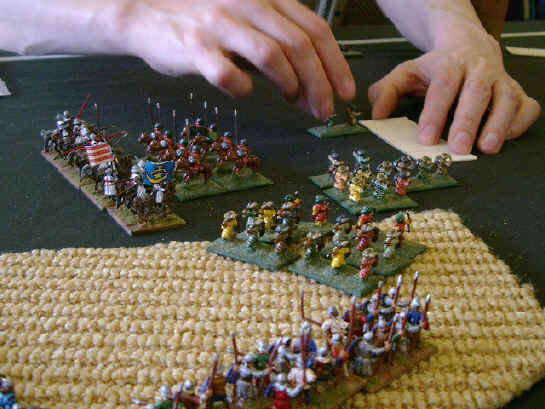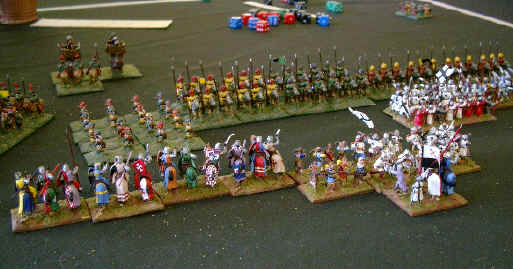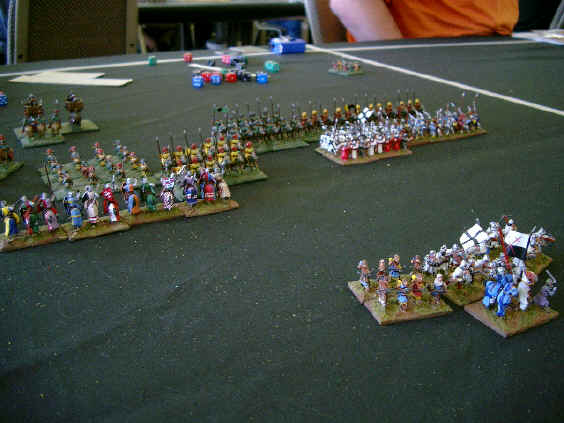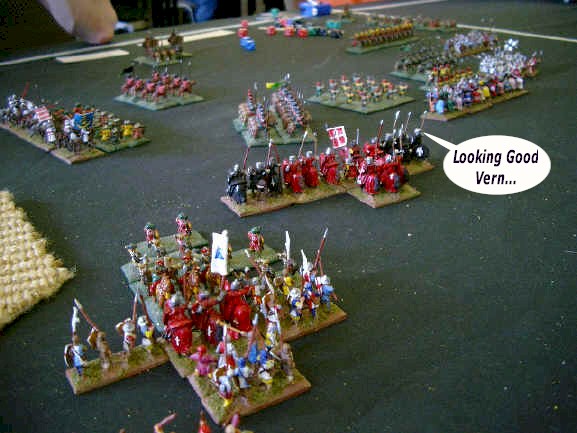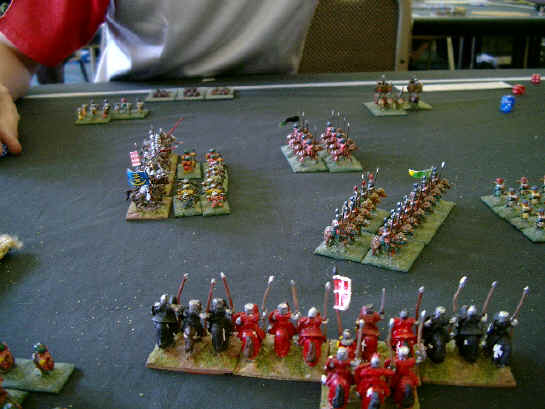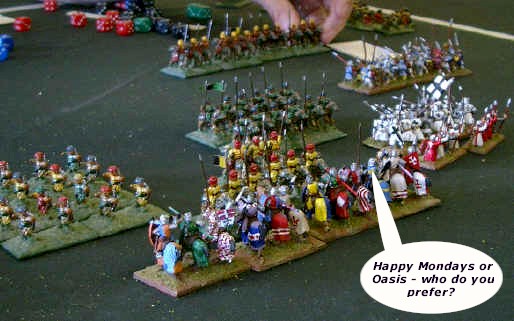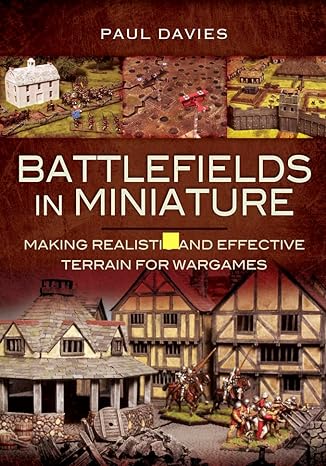Britcon 2007 Game 2
Saturday morning saw me bright and early (well, at some ungodly hour frankly) facing off against a Dailami Army. I had decided to buy some new dice as FoG was seeming to need sets of 6-8 dice in various colours, so I picked up a set of black, red and green ones.
Picking one out for the initiative/terrain roll, I tested them for the first time.
An omen of things to come .....?
I found myself playing a Dailami army on a largely open table, save for a few ploughed fields.
The Dailami were a compact and bijou army, with plenty of Impact Foot - high quality warriors who were good at first impact. They would be a stern test for my Defensive Spearmen!
The Dailami kept my men guessing - in fact, until they advanced into range, many of my men wee convinced they were 17th Century Scotsmen from the Army of Montrose, and we hung back fearing a deadly volley of musketry. But the "bonnets" turned out to be turbans, and normal service was resumed..
My Turcopoles, desperate for redemption, saw a chance to outflank the advancing Dailami, and aided by a General (giving them improved movement) broke through my lines to sweep out to the left flank.
This time my Irregular (sorry, undrilled) Knights were taking no chances about missing out on the action, and had teed themselves up in the middle of the line so they were looking for some Ac-sheee-on ! (when all they needed was cigarettes and alcohol), (dur dur dur durrrr)
The Crusaders were gradually swinging inwards on both wings, but the spearmen were forced to hold back as they did not want to dace the dangerous Dailami swordsmen whilst their formation would be disrupted through traversing a ploughed field. Best to wait for them to come to us, and spring the jaws of the trap as they arrived!
On my right a very solid looking formation was advancing on the cavalry wing of the Dailami army - as the Crusaders inched forwards, they debated whether to maintain the shieldwall or to let their own crossbowmen see the enemy.
Undaunted, the Dailami trained tribesmen charged forward towards my spear line. Well, actually, they were Impact foot, so they charged under orders anyway !
It would be a close run thing - the Dailami had the advantage at contact, but as long as we could survive the initial rush the battle would tip in our favour! It was too close in fact, and to tip the odds back in their favour, the Crusaders tried to shuffle a unit sideways and open up a gap for the Brother Knights to charge through.
CRUNCH!!!!
Dailami slammed in across the line, hitting the crusader foot before they could finish reorganizing, and with the Brothers dangerously still in mid maneuver. If the isolated battlegroup of foot was swept away, the Dailami might burst onto the flank of my knights!!
But whilst the Dailami has got 3 of their 4 warrior units into combat, one was dithering, caught between holding the flank and committing itself to combat. With my turcopoles sweeping round to cut off their retreat - should they wish to - things were looking dicey for the last tribal unit - and even more so as the Crusader Crossbowmen started to find their range!
The Dailami were pushing hard, but by and large my spearmen were holding up well. The isolated battlegroup cracked, but they had hung on long enough for the Brother Knights to finish their redeployment, and the pursuing Dailami were about to get a major surprise. Meanwhile two other tribesmen units were broken, as the overlap at the left of my lines had proved decisive. Both sides now committed generals to the one remaining pivotal combat in a desperate effort to win.
However, what was happening in the middle of the table????
The 2 Dailami elephants had been tip-toeing up the middle of the table, and under the leadership of a general had managed to swing into my irregular (undrilled, doh!!) knights!
With both sides expecting a crushing pachyderm victory, we rolled the dice - and a full set of 6's for the knights was matched by a full set of 1's & 2's for the smellies - who then also catastrophically failed their subsequent cohesion test, and were routed in the melee round - an extraordinary result, that even though it featured some extreme dice, still left the rules development team scurrying back to the drawing board to revisit the factors in this particular interaction !!!
The Crusader infantry and Brother Knights were now in full-on mopping up mode, as they started to sweep the last remnants of the tribal charge from the field. On the other wing the spearmen were also pushing forward relentlessly
The last tribal unit, surrounded and coming under a hail of crossbow bolts, broke and fled as more Crusader spearmen attempted to charge it in the flank. The Turcopoles joined in the rolling up, pressurizing Arab skirmishers and closing off the avenues of escape!!
Attention now fully turned to the other win, as knights, crossbowmen and spearmen pushed forward.
The Dailami Ghulams had been winning the shooting match against the Crusader crossbowmen and had reduced their numbers - they then undertook a last charge causing the crossbowmen to break and flee!!
But by now the Brother knights had recovered and were fast joining the fray
and the Turcopoles continued to sweep through the routing remnants of the Dailami right wing.
Time and table space was running out for the Arabs
Despite coming under withering shooting the Crusaders charged home across the line - and the Undrilled (got it!!) Knights delivered the final coup-de-grace, destroying the Ghulams facing them in a savage charge and tipping the Dailami into defeat.
All in all another good game - and one I felt I had won by doing the right things tactically. The defensive spearmen were proving quite entertaining in the way they always were on the brink of disaster - but as long as they could hang on, they would eventually come good and win though - although having a reserve of Templars was always handy too!
Post Match Analysis
A good victory for the Defensive spearmen - they had ridden the initial impact of the Dailami warriors, and then (bolstered by the presence of a general) had managed to grind down their opponents - and even where the Dailami did achieve a breakthrough, I had gotten up a powerful reserve line in the form of the Brother Knights just in time to counter-punch. From then on the Dailami were looking underpowered against the solid line of spears, and the frightening charge of the knights, and although they caused serious casualties, the tide was running in my favour.
The Knight-elephant interaction seemed very strange - even with extreme dice - and this was flagged to the rules development team by both players as being a bit off kilter. Somewhere deep in the bowels of Slitherine Towers a fix is probably being conjured up as you read this report!
The Ancient Army List Index
The Rise of Rome (280 BC to 25 BC) Mid Republican Roman ; Late Republican Roman ; Gallic ; Pyrrhic ; Later Carthaginian ; Ancient Spanish ; Later Macedonian ; Later Seleucid ; Later Ptolemaic ; Attalid Pergamene ; Numidian or early Moorish ; Pontic ; Early Armenian ; Parthian ; Later Jewish ; Illyrian ; Spartacus Slave Revolt ; Bosporan ;
Storm of Arrows - Western Europe in the Later Middle Ages (1300 AD to 1500 AD) Medieval French ; 100-yrs War English (Continental) ; 100-yrs War English (Britain) ; Later Medieval Scots ( Britain) ; Later Medieval Scots (Continental) ; Later Scots Isles & Highlands ; Medieval Welsh ; Later Anglo-Irish ; Medieval Irish ; Low Countries ; Later Medieval German ; Italian Condotta ; Swiss ; Free Company ; Medieval Burgundian ; Medieval Danish ; Medieval Swedish ; Medieval Castilian ; Medieval Crown of Aragon ; Medieval Portugese ; Later Granadine ; Navarrese ; Ordonnance French ; Wars of the Roses English ; Ordonnance Burgundian ; Santa Hermandad Nueva Castilian
Immortal Fire - The Greek, Persian & Macedonian Wars (550 BC - 146 BC)
Classical Greek ;
Early Achaemenid Persian ;
Lydian ;
Thracian ;
Syracusan ;
Early Carthaginian ;
Skythian or Saka ;
Kyrenean Greek ;
Late Dynastic Egyptian ;
Alexandrian Macedonian ;
Later Achaemenid Persian ;
Classical Indian ;
Early Successor ;
Early Sarmatian ;
Galatian ;
Hellenistic Greek ;
Graeco-Bactrian ;
Graeco-Indian ;
Indo-Greek :
Legions Triumphant - Imperial Rome (25 BC to 493 AD) Dominate Roman ; Principate Roman ; Foederate Roman ; Later Sarmatian ; Early German ; Dacian or Carpi ; Ancient British ; Caledonian ; Early Alan ; Jewish Revolt ; Sassanid Persian ; Kushan or Indo-Skythian ; Palmyran ; Early Frankish, Alamanni, Burgundi, Limigantes, Rugian, Suevi or Turcilingi ; Western Hunnic ; Early Visigothic & Early Vandal ; Early Ostrogothic, Herul, Sciri or Taifali ; Early Anglo-Saxon, Bavarian, Frisian, Old Saxon or Thuringian ; Gepid or Early Lombard ; Early Scots Irish ; Early Pictish ; Hephthalite Hunnic ;
Swords & Scimitars - The Crusades (1096 AD to 1311 AD) Early Crusader ; Later Crusader ; Fatimid Egyptian ; Georgian ; Seljuk Turk ; Cuman ; Komnenan Byzantine ; Post Latin Conquest Byzantine ; Ilkhanid Mongol ; Mamluk Egyptian ; Cilician Armenian ; Syrian States ; Khwarazmian ; Ayyubid Egyptian ; Middle Serbian ; Middle Bulgarian ; Medieval Cypriot ; Latin Greece ; Pecheneg ;
Eternal Empire - Eastern Europe and the Rise of the Ottomans (1300 AD to 1500 AD) Early Ottoman Turkish ; Later Ottoman Turkish ; Tatar ; Later Russian ; Later Serbian Empire ; Later Bulgarian ; Later Lithuanian ; Later Polish ; Later Teutonic Knights ; Catalan Company ; Middle Hungarian ; Moldavian or Wallachian ; Albanian ; Timurid, White Sheep Turcoman or Black Sheep Turcoman ; Later Hungarian ; Hussite ;
Decline & Fall - Byzantium and Islam (493 AD to 1071 AD) Early Byzantine; Maurikian Byzantine ; Thematic Byzantine ; Nikephorian Byzantine ; Later Moorish ; Later Visigothic ; African Vandal ; Italian Ostrogothic ; Early South Slav ; Lombard ; Avar ; Arab Conquest ; Early Bulgar ; Ummayad Arab ; Abbasid Arab ; Early North African Dynasties ; Khurasanian Dynasties ; Bedouin Dynasties ; Dailami Dynasties ; Pecheneg ; Ghaznavid ; Western Turkish (includes Khazar);
Wolves From The Sea - The Hairy European Dark Ages Post Roman British ; Early Welsh ; Later Scots Irish ; Merovingian Frankish ; Later Pictish ; Early Slavic ; Middle Anglo Saxon ; Astur Leonese ; Andalusian ; Early Navarrese ; Carolingian Frankish ; Viking ; Magyar ; Great Moravian ; Early Scots ; Rus ; Norse Irish ; Early Medieval French ; Early Medieval German ; Norman ; Early Polish ; Anglo Danish ;
Swifter Than Eagles - The Biblical Book Nubian ; Early Libyan ; Later Sumerian or Akkadian ; Early Nomad Allies ; Old or Middle Kingdom Egyptian ; Hyksos ; Mitanni ; Syro-Canaanite ; New Kingdom Egyptian ; Later Minoan or Early Mycenaean ; Hittite Empire ; ; Middle or Early Neo-Assyrian ; Later Mycenaean or Trojan ; Sea Peoples ; Philistine ; Phoenician Allies ; Neo-Hittite And Aramaean ; Later Hebrew ; Mannaean Allies ; Libyan Egyptian ; Urartian ; Median ; Neo-Elamite ; Proto-Arab Allies ; Cimmerian or Early Skythian ; Neo-Assyrian Empire ; Phrygian Allies ; Kushite Egyptian ; Neo-Babylonian Empire ;
Oaf of Fealty - Early Medieval Europe Feudal Catalan and Early Crown Of Aragon ; Early Hungarian ; Taifa Andalusian ; Feudal Navarrese and Aragonese ; Feudal Castilian Leonese or Portuguese ; Fanatic Berber ; Italo-Norman ; Feudal French ; Imperial German ; Feudal German ; Communal Italian ; Papal Italian ; Early Scots Isles And Highlands ; Feudal Scots ; Early Russian ; Feudal Polish ; Anglo-Norman ; Later Welsh ; Early Lithuanian or Samogitian ; Wendish Prussian or Estonian ; Early Medieval Frisia and Other Free Cantons ; Post-Viking Scandinavian ; Early Plantagenet English ; Later Sicilian ; Early Medieval Irish ; Early Anglo-Irish ; Early Teutonic Knights ; Mongol Invasion ; Early Granadine ; Middle Plantagenet English ;
Empires of The Dragon - China, Korea and Japan Erlitou-Shang Chinese ; Early Northern Barbarian Allies ; Early Zhou Chinese ; Yayoi Japanese ; Early Horse Nomad ; Ko Choson Korean ; Warring States To Western Han Chinese ; Qiang And Di ; Three Kingdoms Korean ; Eastern Han Chinese? ; Three Kingdoms W Jin And S Dynasties Chinese ; Kofun Nara Japanese ; Northern Dynasties Chinese ; Later Hindu North Indian ; Later Hindu South Indian ; Central Asian City States ; Western Wei To Early Tang Chinese ; ; Later Horse Nomad ; Tibetan ; Nepalese Allies ; Parhae Korean ; Late Tang To Five Dynasties Chinese ; Khmer Or Champa ; Thai Allies ; Nanzhao ; Pyu Burmese Allies ; Koryo Korean ; Early Heian Japanese ; Pagan Burmese ; Liao ; Song Chinese ; Xi Xia ; Ghurid Afghan ; Jin ; Late Heian To Muromachi Japanese ; Japanese Warrior Monk Allies ; Mongol Conquest ; Moslem Indian Sultanates ; Medieval Indonesian Or Malay ; Yuan Chinese ; Medieval Burmese ; Ming Chinese ; Yi Korean
Blood and Gold - The Americas Olmec ; Teotihuacan ; West Mexican ; Zapotec or Mixtec ; Toltec ; Chinantec ; Aztec ; Tarascan ; Tlaxcalan Confederacy ; Mayan ; Mochica ; Chanca ; Chimu ; Hatun-Colla ; Canari ; Inca ; Mapuche or Araucanian ; Amazonian Forest Tribes ; Tupi ; Chichimec ; Pueblo Culture ; Mound-Builder Culture ; South-Eastern Woodland Culture ; Timucuan ; Eastern Woodland Culture ; Plains Culture ; Pacific North-West Culture




